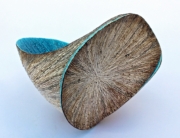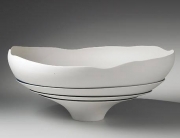Yanagi Muneyoshi founded the Mingei folk art movement, but luxurious Japanese urushi pieces have been popular for centuries. Mingei artists used red, black and various types of colored lacquer patterns to spruce up traditional folk crafts. The Japan Folk-Craft Museum is putting on an exhibition of about 100 different pieces.
The pieces include mother-of-pearl sets, eggshells, abalone and various other media. Mingei artists have been quite eclectic over the years. This exhibit makes that quite clear. It runs through March 24.
Dark lacquer products have long been associated with Japan. In fact, the process of lacquering is sometimes called japanning in English. Early motor vehicles were finished in a color called Japan black. The reason for this association is the great skill that many urushi artists used when making their folk crafts.

Photo credit: Japan Folk-Craft Museum, “Hidehira Bowl, urushi painting with gold leaf, 17th century”
It might interest casual readers to note that urushi is actually made out of what most people would consider a toxin. The plant toxicodendron vernicifluum is a form of ivy that grows throughout Japan and Korea. While its notable for causing people to itch, when the sap is removed and processed it makes a particularly strong adhesive.
That adhesive makes an attractive coating for wood and bamboo. It gives these materials a glossy texture and preserves whatever painting or inlay is underneath them. Japanese artists continued to develop the art form for a great period of time. In fact, artists have moved beyond wood as a medium.
The Japan Folk-Craft Museum is exhibiting some examples of shippi urushi. Shippi refers to lacquered leather, which has developed its own unique following. Like many other crafts, different areas are associated with different styles. Iwate prefecture has a reputation for crafting excellent bowls.
Other areas prefer negoro techniques. Negoro artists cover coats of black lacquer with fresh coats of red lacquer. Other artists combined inlays with lacquer coatings. The raden style encouraged people to put mother-of-pearl inlay work into word before coating it over. These styles became particularly important as the Mingei movement became more popular. When Yanagi Muneyoshi formalized the movement in the 20th century, he had plenty of pieces to choose from.
Exhibitions of these styles have become internationally renown because of Yanagi’s research. As well as his work with the museum, Yanagi’s essay “The Unknown Craftsman” was translated into English in 1972. His written work also appeared elsewhere. The Kogei journal of the Japanese Folk Arts Association was proud to have him as an editor between 1931-1951.




